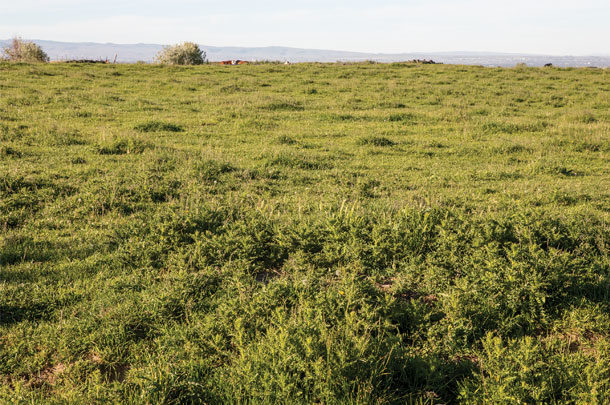- Annual weeds complete their life cycles within a year.
- Winter annuals, such as prickly lettuce or wild mustard, typically germinate in fall, overwinter as seedlings and flower in spring.
- Summer annuals such as spiny pigweed, perilla mint, ragweed, cocklebur and woolly croton germinate in spring or summer and set seed and die in the summer or fall. A hard frost will kill summer annuals.
Sometimes there is some crossover, depending on climate and geography, where winter annuals can act as summer annuals or vice versa.
Biennial weeds take two growing seasons to complete their life cycle. Wild carrot, most thistles, common mullein and burdock are a few examples you may be familiar with. The timing of germination varies widely, but the important thing to know is: Biennials overwinter as a low-growing clump of leaves shaped like a dinner plate. This young plant is called a rosette. Biennials flower, set seed and die sometime in the summer or fall of their second growing season.
Annuals and biennials have to be targeted with herbicides when they are small. For annuals, this means the seedling stage, generally when the plant is less than 6 inches tall. Similarly, biennials need to be sprayed in the seedling or rosette stage. Obviously, all weeds will not be in the same stage at the same time, so there is a bit of an art to observing when the major flushes of various weed species are ready to spray.
The take-home message is: The effectiveness of herbicides drops rapidly once plants begin rapid upright growth and formation of a seed stalk – otherwise known as “bolting.” Once bolting starts, you’ll get better results by cussing at the weeds than you will by spraying them, and it’s much cheaper. Unfortunately, there are a lot of farmers who wait until their thistle or cocklebur patches are waist-high before spraying them.
It doesn’t achieve much, which is why I often hear it referred to as “recreational spraying.” In general, spray for summer annuals in early summer. Winter annuals and biennials are best targeted in mid-fall through late winter, depending on where you are located. Here in Virginia, there can be some mild winter days that are perfect for killing next summer’s crop of thistles.
I’m going to go out on a limb and offer a couple of simple herbicide recipes for annual and biennial broadleaf weeds in cool-season forages, since there are some general ones that work well no matter where you live, provided you get the timing right. It goes without saying you should follow the label and research your specific situation before using any herbicide. The rates I’ve shown are middle-of-the-road (read the label for more guidance).
I’ve given the per-acre recipe, but if you are in more of a spot-spray scenario, you can reduce it to a per-gallon basis. Most people in this situation tend to apply at a heavier rate, so the spray mixture concentration required will be lower. When spot spraying, if you spray foliage until thoroughly wet but not to the point of runoff, you are likely somewhere around 80 gallons per acre. Armed with this knowledge, we can adapt the recipe for small batches. It works well to use a disposable syringe to measure small amounts by milliliter, so I’ve included that here as well (see Table 1).

Perennial weeds are a whole different beast. When young, they are much the same as an annual or biennial that is in the seedling stage – relatively small and susceptible to herbicides. Once established, however, perennial weeds contain extensive stores of energy that allow them to regrow despite your hard work with the bush hog or sprayer. Dogbane, milkweed, horse nettle, Canada thistle, devil’s shoestring, leafy spurge – sound familiar?
Given free rein, they will come back stronger each year. Often, perennials possess creeping root systems or underground stems (rhizomes) that not only store energy but also allow it to spread from the mother plant to form large colonies. You’ve no doubt seen this for yourself and would likely not be surprised to learn a weed patch acres in size could theoretically be one plant.
The secret to control lies again in timing. An established perennial should be targeted with herbicides when it is close to or just starting to develop flower buds (usually around one-quarter the plant’s mature height) in late spring or early summer. Since herbicides move like sugars within the plant, spraying too early in the season (when sugars are still flowing upward from the roots) will result in herbicide that fails to reach below-ground portions of the plant. The early bud stage, however, matches the downward flow of plant sugars to the roots and also coincides with low energy stores in the plant.
Plants in full flower and seed production again pull resources from below ground, so this stage tends to be a bad time to spray. Fall spraying is usually very effective, since many perennials are done flowering for the year and are busy sending sugars below ground for winter storage. Regardless of the time of year, the stage of plant growth is the most important thing to note, as mowing or weather can easily wreck any rules of thumb for timing based on the calendar.
The best herbicides for perennials tend to be in the pyridine family. These herbicides move well within the plant and have long-lasting residual activity in the soil, which provides extended root uptake. They are persistent in soils, plants, hay and manure, so there are very specific restrictions for their use – particularly in hay. They kill clover and other legumes as fully as they kill weeds, so you should save their use for controlling out-of-hand weed situations. Here are some example recipes (see Table 2).

When dealing specifically with woody perennials, such as brambles or autumn olives, it is best to select a product containing fluroxypyr or triclopyr. For example, the previous recipe for triclopyr + 2,4-D would be a good option.
Now that you’re ready to go out and spray, please be responsible: Don’t spray near your neighbor’s tomato plants, leave a buffer around the spring creek where you caught trout as a kid, and protect some habitat for the honeybees to forage on. Remember, reoccurring weed infestations are just symptoms of underlying agronomic problems. Use herbicides to help get the problem under control, but focus on restoring the health and competitiveness of your field with good soil fertility and proper grazing management. ![]()
PHOTO: Pasture. Photo by Mike Dixon.

-
Matt Booher
- Virginia Cooperative Extension
- Augusta County
- Email Matt Booher










